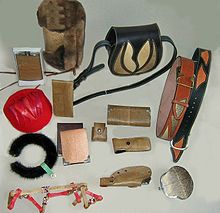Fish leather
Fish leather is made from the skin of fish.
history

Fish leather is not a new product because the skin of fish was processed into leather very early in Europe . In the absence of more suitable leather, insoles and drive belts are said to have been made from durable fish skins during the Second World War . In 1939 there were ten factories in Germany which, in addition to other types of leather, also produced fish leather by hand. In 1940 clothes and shoes made of fish leather were presented in the "Frankfurt Modeamt".
Even among primitive peoples , there are only a few people left today who have mastered this processing. Here are e.g. B. the Nanai in Siberia , on the Amur river . They were called "barbarians in fish skins" by the Chinese. They not only made clothing from fish skins, but also tents and boat hides. In 2007 a native Nanai made a decisive contribution to the establishment of a fish leather museum in the Bavarian Forest.
In Japan , hand rubbing ( Oroshiki ) was used with shark leather (Samegawa-Oroshi).
Todays use
An industrial method of fish leather processing was developed around 2007 in Bavaria . Even with this processing, the fish leather is very soft, elastic and light. Its durability corresponds to the best known types of leather such as cowhide and calf leather. The material is very individual, as no two skins are the same. Fish leather is processed into shoes, clothes, bags, ties, hats, trousers and accessories. The smell corresponds to that of other leathers. Although the fish leather has no scales after processing, the skin structure with the scale pattern remains, depending on the type.
The most common types of fish for leather production include eels , carp , trout , salmon , tilapia and rays .
Species protection
Fish leather looks very exotic, so it can replace the skin of endangered reptiles . Since there are enough fish skins of non-threatened species from the waste products of the fish factories, this could make a contribution to species protection.
literature
- Hans Herfeld (ed.): Library of leather. 10 volumes, Umschau Verlag, Frankfurt am Main 1990, ISBN 3-524-82004-2 .
- Gerhard E. Moog: The tanner. Leather making manual. Ulmer (Eugen), Stuttgart, 2005, ISBN 3-8001-1228-0 .
- Lotta Rahme, Dog Hartman: Fish Leather: tanning and sewing with traditional methods. Lottas Tannery, Sigtuna 2012, ISBN 978-91-637-1661-4 .
Web links
- Fish leather: as revolutionary as the first flight into space on de.rbth.com, accessed on April 11, 2017.
- Fish leather on leder-info.de, accessed on April 11, 2017.
- This Woman Is Turning Fish into Shoe Leather on munchies.vice.com, accessed April 14, 2017.
Individual evidence
- ↑ Helmut Maier: Armaments research in National Socialism. Organization, mobilization and delimitation of the technical sciences. Wallstein Verlag, 2002, ISBN 978-3-89244-497-8 , p. 228.
- ↑ Nadia Jackinsky-Sethi: Fish Skin as a Textile Material in Alaska Native Cultures. In: First American Art Magazine. No. 5, 2014, online (PDF; 6.83 MB), at academia.edu, accessed on April 12, 2017.
- ↑ Fish-Skin Clothes ( Memento of the original from July 3, 2009 in the Internet Archive ) Info: The archive link was inserted automatically and has not yet been checked. Please check the original and archive link according to the instructions and then remove this notice. on chinaculture.org, accessed April 11, 2017.
- ↑ a b Amur-Art-Museum at amur-art-museum.de, accessed on April 11, 2017.
- ↑ Fischledermuseum e. V. Viechtach ; Bavarian Forest , on donkan.de, accessed on April 11, 2017.
- ↑ Ferdinand Pax (ed.): Sea products. A concise dictionary of marine raw materials. Verlag Gebr. Borntraeger, Berlin 1962, ISBN 3-443-39033-1 , pp. 95/96.
- ↑ The magazine brand eins reported in the 03/2008 issue that Europe's largest salmon smokehouse, Laschinger GmbH, Bischofsmais, in the Bavarian Forest became Salmo Leather GmbH. Its development manager is Anatol Donkan , he is the aforementioned Nanai, founder of the fish leather museum. At brandeins.de , accessed on April 11, 2017.
- ↑ Different types of fishermen's fish; Full text search: Fischleder on materialarchiv.ch, accessed on April 11, 2017.

